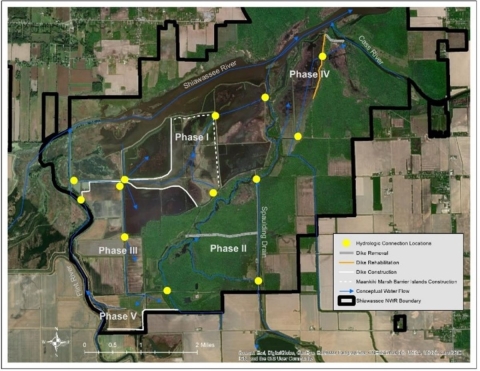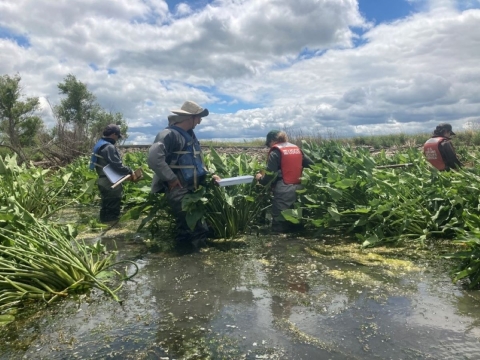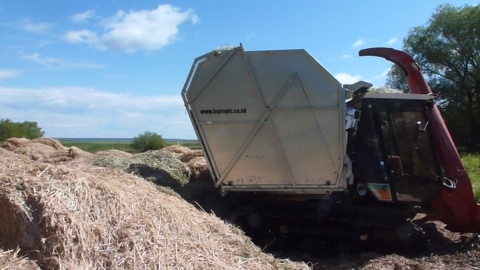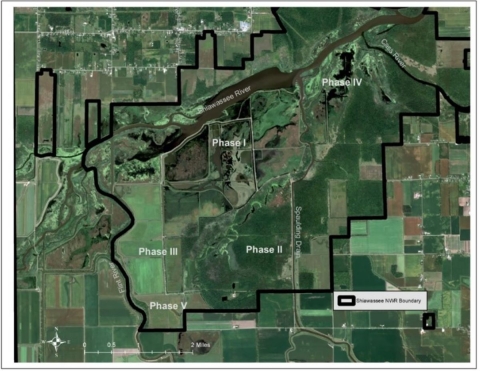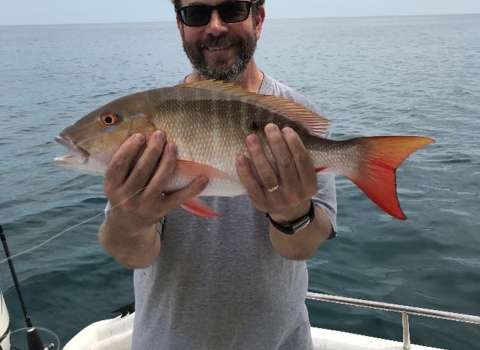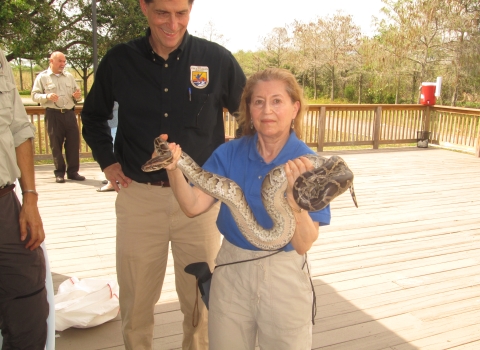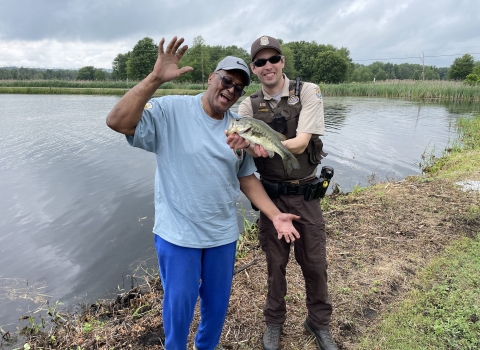Eric Dunton is a wildlife biologist stationed at Shiawassee National Wildlife Refuge (NWR) in Michigan, where he has worked since 2010. He is also a field-based inventory and monitoring biologist for the Midwest Region’s inventory and monitoring initiative, and the USFWS Library’s latest FWS scholar. Eric grew up on a farm in southern Michigan and always wanted a career in the conservation and natural resources field, particularly working with wetlands and waterfowl. He holds a B.S. in fisheries and wildlife management from Michigan State University and a M.S. in biology, with an emphasis on wildlife, from Tennessee Technological University. Eric’s master’s research focused on giant Canada geese in central Tennessee. Eric lives near Shiawassee National Wildlife Refuge, where he enjoys spending time with his family taking them hunting and fishing and coaching his sons in baseball.
Upon completion of his master’s degree, Eric worked as a contract biological science technician for the Department of Defense at Fort Benning in southern Georgia, evaluating the impact of the development of a multipurpose range complex on federally endangered red-cockaded woodpeckers. He worked as a wildlife technician for Michigan Department of Natural Resources Wildlife Division at Pointe Mouillee State Game Area, a managed wetland area on Lake Erie, and served as an acting wildlife biologist in southern Michigan. Eric also worked for Minnesota Department of Natural Resources as a wildlife research biologist at the Farmland Wildlife Populations and Research group. In this role, most of his research was focused on wildlife surveys, population survey techniques and estimates, and various topics related to wild turkeys throughout the state.
Over the last decade, Eric and the staff at Shiawassee NWR developed a multi-phased restoration plan to restore over 1,500 acres of agricultural land, primarily funded through the Great Lakes Restoration Initiative (GLRI). This work has focused on restoring coastal wetlands and hydrologic re-connection of disconnected wetlands and floodplains within the refuge. As the work was being planned, Eric developed a partnership with U.S. Geological Survey Great Lakes Science Center and the University of Michigan School for Environment and Sustainability. From 2012 through 2017, a team of eight students and five thesis-based master’s students collected pre-restoration data on waterbirds, fish, macroinvertebrates, vegetation, water quality and nutrient flux, and a variety of other factors. In 2019, post-restoration monitoring began, and the final year of data collection is just wrapping up. This work involved four graduate student teams and 20 total students. A final graduate student team is finalizing their group thesis and then the partnership plans to begin conducting final analysis of all the pre- and post-restoration data.
There are many challenges to managing and restoring coastal wetlands in a highly altered and agricultural dominated landscape, including excess nutrients and invasive species invasive species
An invasive species is any plant or animal that has spread or been introduced into a new area where they are, or could, cause harm to the environment, economy, or human, animal, or plant health. Their unwelcome presence can destroy ecosystems and cost millions of dollars.
Learn more about invasive species . As many of these former agricultural fields were restored, many became dominated with invasive cattail (Typha x glauca), which thrives in nutrient rich environments and over time degrades wetland habitat for many species of freshwater marsh waterbirds (e.g., waterfowl, shorebirds, wading birds, and secretive marsh birds). The refuge manages by creating dense, litter-clogged stands that exclude native wetland vegetation.
Eric developed a partnership with Loyola University Chicago School for Environmental Sustainability and The Nature Conservancy to experimentally evaluate the effects of harvesting invasive plants and their litter. In their recent journal article titled, “Wetland Waterbird Food Resources Increased by Harvesting Invasive Cattails”, the group demonstrated that harvesting cattail and moving the biomass off site increased the abundance of waterbird seed and tuber producing plants by five times, and increased annual plant dominance by 10 times, while substantially reducing all measures of cattail and its litter. Furthermore, bird use days increased for all waterbirds including waterfowl and dabbling ducks following treatment. Cattail cover decreased and open water and non-cattail emergent vegetation cover increased. Harvesting invasive plant biomass coupled with flooding promoted a plant community composition and structure structure
Something temporarily or permanently constructed, built, or placed; and constructed of natural or manufactured parts including, but not limited to, a building, shed, cabin, porch, bridge, walkway, stair steps, sign, landing, platform, dock, rack, fence, telecommunication device, antennae, fish cleaning table, satellite dish/mount, or well head.
Learn more about structure beneficial to waterbirds. The harvested invasive plants contain large amounts of stored nutrients, was applied to a neighboring private land agricultural field. The group is currently analyzing data and working on a publication to evaluate the use of above ground cattail biomass as a soil amendment in agricultural fields.
The refuge and partners from Loyola University of Chicago School for Environmental Sustainability were recently awarded $1.2 million in GLRI funds to continue this work. The next phase of work consists of harvesting 200 acres of invasive cattail and converting it to biochar, then reapplying to the restored wetland. Laboratory and small-scale field experiments have shown biochar’s capacity to chemically immobilize reactive nitrogen and phosphorus, bind heavy metal pollutants, buffer changes in pH, and increase long-term soil carbon storage. Additionally, preliminary research indicates that biochar application to wetland soils significantly decreases invasive cattail growth by reducing plant available nutrients. Thus, biochar application in wetland restoration has great potential to achieve the multiple benefits of reducing invasive plant re-growth, limiting nutrient runoff, and increasing soil carbon storage, but it has not yet been tested at a large scale.
To learn more about invasive species management, restoring coastal wetlands and Eric Dunton's research, read his full article on Harvesting Invasive Cattails. The USFWS Library is celebrating our Service scientists who are committed to science excellence and the work of conservation through the FWS Scholar series. If you are an FWS employee, have recently published peer-reviewed scientific literature, and would like to be featured as an FWS Scholar, let us know at library@fws.gov!


